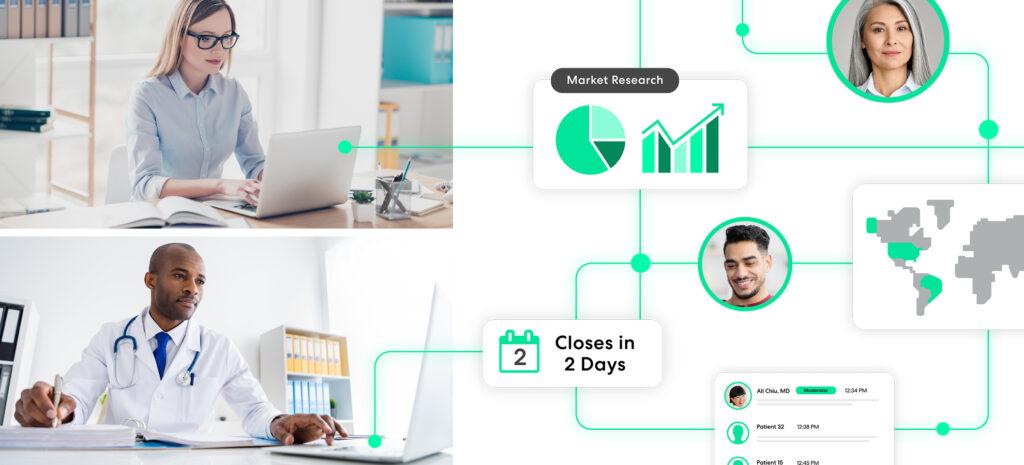Big data analytics for clinical trials provide companies the ability to process and interpret a large volume and variety of information that is accumulated at great speed. This ability is contributing to the increased use of big data and related technologies in the pharma or healthcare industry, specifically in clinical trials. Therefore, it’s not surprising that health care and pharmaceutical companies made nearly $5 billion in big data investments in recent years.
Pharmaceutical companies have long relied on data to identify patterns, test theories, and understand the efficacy of treatments. In this article, we’ll examine how big data analytics helps clinical trial researchers streamline complex processes and improve efficiency throughout clinical study development and execution.
What are the primary types of clinical trials?
Clinical research is simply the study of human volunteers, or clinical trial participants, that help doctors and researchers learn about new solutions to health problems. Data from clinical trials are then examined using big data analytics to determine whether certain therapies will continue to progress through the drug development progress.
The primary types of clinical research are observational and clinical trials.
Observational trials
One type of clinical research is observational trials, where researchers gather data from people in normal settings. No specific new drug or medical device, procedural or behavioral intervention is done with these clinical trial participants, as is done in clinical trials. For example, a clinical researcher may observe a group of older volunteers over a period of time to measure the effects of aging or lifestyle on cognitive or cardiac health.
Clinical trials
A clinical trial is a research study of humans to test the safety and effectiveness of a specific medical, surgical, or behavioral intervention. A lead investigator heads every study, usually a medical doctor, with a research team of doctors, nurses, and other HCPs. They may study new drugs or medical devices, different surgical techniques, better use of existing treatments, or behavioral changes that can improve health.
Before a clinical trial for humans is approved by the Food and Drug Administration (FDA), preclinical research must be performed in labs to answer basic questions about a new therapy’s safety. Then a clinical trial is run according to the medical research plan or protocol created by the researchers or manufacturer. The protocol addresses:
- Why the study is being conducted
- Who may participate in the study
- Number of participants needed
- How long the study should last
- Schedule of tests, procedures, drugs, and their dosages
- What assessments will be done, and when
- What data will be collected, and how it will be analyzed
The primary, but not only, types of clinical trials include:
- Screening trials test new potential advancements in detecting health conditions and diseases.
- Diagnostic trials look for more effective methods, like tests and procedures, to identify certain illnesses or conditions.
- Treatment trials test interventions such as treatments, new drug combinations, medical devices, and different approaches to surgeries and other therapies.
What are the implications for big data analytics in pharma?
The outcome of clinical trials can serve as a key performance metric for investors, as well as a starting point for collaboration between the healthcare industry, payers, and health technology assessment groups. According to tech writer Melissa Lin: “Big data analytics involves the collection, manipulation, and analysis of massive, diverse clinical data sets. It provides promise for pharma companies in several ways: 1) Predictive modeling can unearth targets for the drug pipeline. 2) Statistical tools can improve patient recruitment and enhance monitoring. 3) Data mining of public forums and social media sites can identify adverse drug reactions not formally reported.”
Accumulating, archiving, organizing, disseminating, and opening large real-world data, pharma data, and clinical trial data sets across an entire pharmaceutical enterprise involves several challenges and critical decisions for an implementation that must be based on intended future uses of that data and the organization’s future strategy.
Consulting firm McKinsey believes there is long-term value in big data analytics for clinical trials. “Implementing end-to-end data integration requires a number of capabilities, including trusted documents and data sources the ability to establish cross-linkages between elements, robust data quality assurance, workflow management, and role-based access to ensure that specific data elements are visible only to those who are authorized to see it. Pharmaceutical companies generally avoid overhauling their entire clinical data-integration system at once because of the logistical challenges and costs involved, although at least one global pharmaceutical enterprise has employed a “big bang” approach to remaking its clinical IT systems.”
How is big data used in clinical trials?
Big data can be used in many ways throughout the clinical trial process. One intriguing use case is to use big data to help pharma organizations enroll more people into clinical trials – a primary concern during the process and often where clinical trials get bogged down or fail altogether.
People who are recruited to join clinical trials may become part of the experimental group – the people who receive the drug or treatment being investigated – or the control group, who receives no treatment, a placebo, or the current standard of care. But what if investigators could use all of the recruited participants as the experimental group, thereby gathering more data points? From MIT Technology Review:
“The idea is to reuse data from patients in past trials to create “external control arms.” These groups serve the same function as traditional control arms, but they can be used in settings where a control group is difficult to recruit: for an extremely rare disease, for example, or conditions such as cancer, which are imminently life-threatening. They can also be used effectively for “single-arm” trials, which make a control group impractical: for example, to measure the effectiveness of an implanted device or a surgical procedure. Perhaps their most valuable immediate use is for doing rapid preliminary trials, to evaluate whether a treatment is worth pursuing to the point of a full clinical trial.”
Pairing big data with other technology, such as that used in EDC clinical trials, can also help to accelerate the trial process and make data cleaner and more reliable, as well as more accessible to anyone who needs to use it. Big data analytics may also increase the value of clinical trial data sharing, which increases trial participants’ contributions to generalizable knowledge about human health by potentially facilitating additional findings beyond the original, prespecified clinical trial outcomes. The use of big data analytics may also have implications for improving the diversity of demographic data in clinical trials, particularly in examples like the above, where investigators can use all recruited participants as an experimental group.
While big data analytics have a number of positive implications for the future of clinical trials, there are also roadblocks. HIPAA compliance requirements were an early attempt to protect people from the negative impact of networked data. Reporting published by Cambridge University Press says: “Fundamental characteristics of big data challenge the structure of how we regulate human subjects research, the impact of HIPAA, and how we think of health care itself…HIPAA imposes a tangled web of regulation that hampers the use of healthcare data.”
How do clinical teams use insights management and virtual engagement?
Life science companies’ clinical teams faced the COVID-19 pandemic’s restrictions with flexibility, shifting most activities to virtual environments. Teams quickly discovered that they needed more than video conferencing platforms and instant messaging to ensure safe and successful studies. Instead, they began to enable asynchronous engagement with HCPs, investigators, patients, and other trial stakeholders at every phase of drug and device clinical development. To learn more about how clinical teams use an insights management platform to improve their work, download our white paper.






